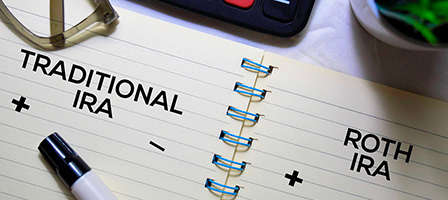October 18, 2022
Is This an Opportune Time to Convert Your Traditional IRA to a Roth IRA?
Found In:

Article Highlights:
Why would you want to do that? Because Roth IRA distributions provide tax free retirement benefits while payouts from Traditional IRAs are taxable.
Of course there is no assurance that the markets will not continue to decline, and this may not be the most opportune time to make a conversion in your specific circumstances but is something you may want to consider. Conversions provide the most benefit to younger individuals who can look forward to many years of the tax-free growth provided by a Roth IRA.
You don’t have to convert all of your traditional IRA in one year. You can convert what you can afford to pay the tax on each year.
Here Is How It Works – The tax code allows individuals to convert any portion of their traditional IRA to a Roth IRA by paying tax on the conversion as though taking a distribution from the traditional account. Thus, if you make a conversion you are taxed on the conversion based upon the tax rates that apply to your normal income plus the traditional IRA amount being converted.
Of course, if in 2022 you have abnormally lower income, that could make the conversion tax even less. The following table includes the marginal tax rates for 2022.
Other Issues:
- Stock Markets Downward Slide
- Traditional IRA to a Roth IRA Conversions
- Younger Individuals
- Here Is How It Works
- Marginal Tax Rates
- Example When Using the Marginal Table
- Conversions Cannot Be Undone.
- Non-deductible Traditional IRA Contributions
Why would you want to do that? Because Roth IRA distributions provide tax free retirement benefits while payouts from Traditional IRAs are taxable.
Of course there is no assurance that the markets will not continue to decline, and this may not be the most opportune time to make a conversion in your specific circumstances but is something you may want to consider. Conversions provide the most benefit to younger individuals who can look forward to many years of the tax-free growth provided by a Roth IRA.
You don’t have to convert all of your traditional IRA in one year. You can convert what you can afford to pay the tax on each year.
Here Is How It Works – The tax code allows individuals to convert any portion of their traditional IRA to a Roth IRA by paying tax on the conversion as though taking a distribution from the traditional account. Thus, if you make a conversion you are taxed on the conversion based upon the tax rates that apply to your normal income plus the traditional IRA amount being converted.
Of course, if in 2022 you have abnormally lower income, that could make the conversion tax even less. The following table includes the marginal tax rates for 2022.
|
Marginal Tax Rates for 2022
|
||||
| Marginal Rate |
Filing Status
|
|||
| -- | Single | HH | MFJ | MFS |
| 10.0% | 0 - 10,275 | 0 - 14,650 | 0 - 20,550 | 0 - 10,275 |
| 12.0% | 10,276 - 41,775 | 14,651 - 55,900 | 20,551 - 83,550 | 10,276 - 42,775 |
| 22.0% | 41,776 - 89,075 | 55,901 - 89,050 | 83,551 - 178,150 | 42,776 - 89,075 |
| 24.0% | 89,076 - 170,050 | 89,051 - 170,050 | 178,151 - 340,100 | 89,076 - 170,050 |
| 32.0% | 170,051 - 215,950 | 170,051 - 215,950 | 340,101 - 431,900 | 170,051 - 215,950 |
| 35.0% | 215,951 - 539,900 | 215,951 - 539,900 | 431,901 - 647,850 | 215,951 - 323,925 |
| 37.0% | 539,901 and Above | 539,901 and Above | 647,850 and Above | 323,926 and Above |
Other Issues:
- There is no income limitation on making a conversion, thus anyone can do a conversion.
- Higher income taxpayers can use the conversion to circumvent the AGI limits for contributing to a Roth IRA.
- Once a conversion is made it cannot be undone.
- Some individuals for various reasons have made non-deductible contributions to their traditional IRAs. For distribution or conversion purposes, all an individual’s IRAs (except Roth IRAs) are considered as one account and any distribution or converted amounts are deemed taken ratably from the deductible and non-deductible portions of the traditional IRA, and the portion that comes from the deductible contributions would be taxable.










